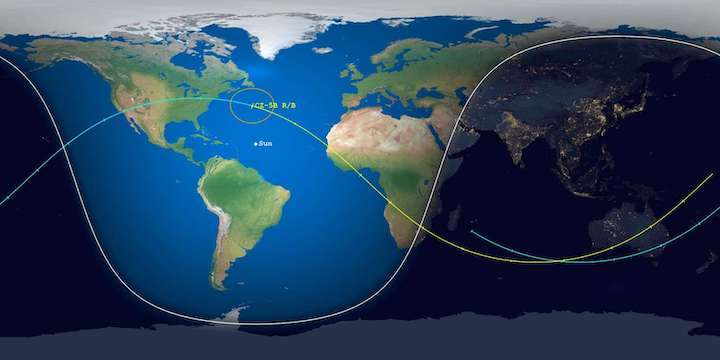12.05.2020

A large rocket stage left in space after the successful launch of China’s heavy-lift Long March 5B rocket May 5 fell into the atmosphere Monday over the Atlantic Ocean, becoming the most massive object in nearly 30 years to perform an uncontrolled re-entry from orbit.
The Long March 5B rocket’s core stage re-entered the atmosphere at 11:33 a.m. EDT (1533 GMT) Monday, according to the U.S. Space Force’s 18th Space Control Squadron. At that time, the rocket was flying over the Atlantic Ocean off the west coast of Africa.
The re-entry occurred less than 15 minutes after the rocket body soared almost directly over New York City.
The rocket’s core stage measured around 100 feet (30 meters) long and 16 feet (5 meters) wide, with a mass of approximately 20 metric tons.
The spent rocket was the most massive object to re-enter the atmosphere in an unguided fashion since the Soviet Union’s Salyut 7 space station in 1991, according to Jonathan McDowell, an astronomer at the Harvard-Smithsonian Center for Astrophysics who tracks global satellite and launch activity.
While the size of the Long March 5B’s core stage made Monday’s unguided re-entry remarkable, most of the rocket was expected to burn up as it plunged back into the atmosphere. Most of the rocket was made up of hollow propellant tanks, but the dense turbomachinery of the core stage’s two YF-77 main engines could have survived the fall from space.
The Long March 5B rocket lifted off May 5 from the Wenchang launch center on Hainan Island in southern China, carrying a prototype for China’s next-generation crew capsule into orbit on an unpiloted test flight.
The launch May 5 marked the debut of a new configuration of China’s heavy-lift Long March 5 rocket. On the Long March 5B, Chinese designers removed the rocket’s second stage and replaced it with a longer volume for payloads.
The Long March 5B is designed to launch modules for China’s planned space station. It launched with four kerosene-fueled strap-on boosters, which dropped off the rocket around three minutes after liftoff, and a hydrogen-fueled cryogenic core stage that entered orbit along with the crew capsule testbed.
Without reignitable engines, the core stage was left in a low-altitude orbit where it quickly succumbed to atmospheric drag.
Dead satellites and old rocket stages regularly re-enter the atmosphere, but re-entering objects with masses of more than a few tons are rare.
Space agencies, launch operators and satellite companies often try to guide spent rocket stages and aging satellites toward re-entries over the ocean, reducing the risk that debris could fall over a populated area.
Uncontrolled re-entries are difficult to predict, and forecasts issued by the U.S. military narrowed the window for the rocket’s fall back to Earth in the days before re-entry. Ground-based radars tracked the Long March 5B rocket body in space, allowing U.S. military officials charged with monitoring space debris to regularly measure the core stage’s decaying orbit.
A one-minute error in predicting a re-entry time for an object in low Earth orbit changes the location of potential falling debris by nearly 300 miles, or about 500 kilometers, according to the Aerospace Corp.
The Long March 5B rocket body flew in an orbit between 41.1 degrees north and south latitude, meaning the re-entry could have occurred as far north as around New York City, or as far south as Wellington, New Zealand. In the end, any debris from the core stage that survived the re-entry appeared to fall over the sea, well away from populated areas.
China plans to launch at least three more Long March 5B rockets in 2021 and 2022 with modules for the country’s planned space station, so more uncontrolled rocket re-entries are expected in the next couple of years.
The most massive human-made object to re-enter the atmosphere from orbit was Russia’s Mir space station, which made a guided re-entry over the South Pacific Ocean in 2001. NASA and Russia’s space agency have plans to eventually execute a controlled re-entry of the International Space Station at the end of its service life.
Quelle: SN
